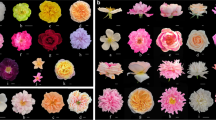Summary
Seeds from two morphologically different groups in an Erophila verna dune population were used in a growth experiment to analyse and quantify flexibility and plasticity of growth and reproductive characteristics.
A strong correlation between plant morphology and individual seed weight was shown in parents and progeny. Seeds of plants with narrow leaves were twice as heavy (H-plants) as those from plants with broad leaves (L-plants) Families of H-plants allocated ca. 10% more dry matter to the roots. These characters were fixed, presumably due to selfing. Plants of both types are characterized by a graded control function between the vegetative and the reproductive phase. Most of the families showed a single switch from vegetative to reproductive growth, two families showed even two switch periods.
Between-family differentiation is interpreted as a result of multiniche selection in populations of Erophila verna. Within-family variation is disadvantageous due to low fecundity.
Similar content being viewed by others
References
Baker HG (1972) Seed weight in relation to environmental conditions in California. Ecology 53:997–1010
Bannier JP (1924) Untersuchungen über apogame Fortpflanzung bei einigen elementaren Arten von Erophila verna. Thesis, University of Utrecht
Bolkhovskikh Z, Grif V, Matvejeva T, Zakharyeve O (1969) Chromosome numbers of flowering plants. Academy of Science, Leningrad, USSR
Clegg MT, Allard RW, Kahler AL (1972) Is the gene the unit of selection? Evidence from two experimental plant populations. Proc Nat Acad Sci (USA) 69:2474–2478
Cohen D (1971) Maximizing final yield when growth is limited by time or by limiting resources. J Theor Biol 33:299–307
Ennos RA (1985) The significance of genetic variation for root growth within a natural population of white clover (Trifolium repens). J Ecol 73:615–624
Ernst WHO (1981) Ecological implications of fruit variability in Phleum arenarium L., an annual dune grass. Flora (Jena) 171:387–398
Ernst WHO (1983a) Anpassungsstrategien einjähriger Dünenpflanzen. Verhandlungen der Gesellschaft für Ökologie (Mainz 1981) 10:485–495
Ernst WHO (1983b) Element nutrition of two contrasted dune annuals. J Ecol 71:197–209
Ernst WHO (1983c) Ökologische Anpassungsstrategien an Bodenfaktoren. Ber Deutschen Bot Ges 96:49–71
Ernst WHO (1985) Schwermetallimmissionen-ökophysiologische und populationsgenetische Aspekte. Düsseldorfer Geobot Kolloquien 2:43–57
Gottlieb LD (1984) Genetics and morphological evolution in plants. Amer Nat 123:681–709
Griesinger R (1935) Zytologische und experimentelle Untersuchungen an Erophila verna. Flora (Jena) 129:363–379
Grubb PJ (1977) The maintenance of species richness in plant communities: the importance of the regeneration niche. Biol Rev 52:107–145
Grubb PJ, Kelly D, Mitchley J (1982) The control of relative abundance in communities of herbaceous plants. In: Newman EI (ed) The Plant Community as a Working Mechanism. Black-well, Oxford. pp 79–97
Kannenberg LW, Allard RW (1967) Population studies in predominantly self-pollinated species. VIII. Genetic variability in the Festuca microstachys complex. Evolution 21:227–240
Kelly D (1984) Seeds per fruit as a function of fruits per plant in ‘depauperate’ annuals and biennials. New Phytol 96:103–114
King D, Roughgarden J (1982) Multiple switches between vegetative and reproductive growth in annual plants. Theor Popul 21:194–204
King D, Roughgarden J (1983) Energy allocation patterns of the Californian grassland annuals Plantago erecta and Clarkia rubicunda. Ecology 64:16–24
Linhart VB (1974) Intrapopulation differentiation in annual plants. I. Veronica peregrina L. raised under non-competitive conditions. Evolution 28:232–243
Matuskiewicz W (1948a) Some researches on the variation of Erophila verna D.C. Annales Universitatis Mariae Curie-Sklodowska 3:1–18
Matuskiewicz W (1948b) Taxonomic studies on Erophila verna D.C. II. A contribution to the knowledge of weeds. Biometric and statistic investigations. Annales Universitatis Mariae Curie-Sklodowska 3:18–47
Newell SJ, Tramer EJ (1978) Reproductive strategies in herbaceous plant communities during succession. Ecology 59:228–234
Paltridge GW, Denholm JV (1974) Plant yield and the switch from vegetative to reproductive growth. J Theor Biol 44:23–34
Primack RB (1979) Reproductive effort in annual and perennial species of Plantago (Plantaginaceae). Amer Nat 114:51–62
Rosen F (1889) Systematische und biologische Beobachtungen über Erophila verna. Bot Zeitung 47:565–596
Rosen F (1910) Über Bastarde zwischen elementaren Spezies der Erophila verna. Berichte der Deutschen Botanischen Gesellschaft 28
Rozijn NAMG (1984) Adaptive strategies of some dune annuals. Thesis, Free University Amsterdam
Salisbury EJ (1942) The reproductive Capacity of Plants; Studies in quantitative Biology. Bell, London
Schaal BA (1984) Life-history variation, natural selection, and maternal effects in plant populations. In: Dirzo R, Sarukhán J (eds) Perspectives on Plant Population Ecology. Sinauer Associates Publ, Sunderland (Mass.) pp 188–206
Schulz OE (1927) Cruciferae — Draba et Erophila. Das Pflanzenreich, Regni Vegetabilis Conspectus 4:343–372
Stebbins GL (1976) Seed and seedling ecology in annual legumes. I. A comparison of seed size and seedling development in some annual species. Oecol Plant 11:321–331
Symonides E (1983) Population size regulation as a result of intrapopulation interactions. II. Effect of density on the growth rate, morphological diversity and fecundity of Erophila verna (L.) C.A.M. individuals. Ekol Polska 31:883–912
Thompson JN (1984) Variation among individual seed masses in Lomatium grayi (Umbelliferae) under controlled conditions: magnitude and partitioning of the variance. Ecology 65:626–631
Turesson G (1929) Zur Natur und Begrenzung der Artenheiten. Hereditas 12:323–334
Van Andel J, Nelissen HJM, Wattel E, Van Valen TA, Wassenaar AT (1984) Theil's inequality index applied to quantfy population variation with regard to dry matter allocation. Acta Bot Neerl 33:161–175
Van der Aart PJM (1985) Demographic, genetic and ecophysiological variation in Plantago major and Plantago lanceolata in relation to vegetation type. In: White J The Population Structure of Vegetation. Junk Publ Dordrecht pp 441–462
Watkinson AR (1978) The demography of a sand dune annual: Vulpia fasciculata. II. The dynamics of seed populations. J Ecol 66:35–44
Winge Ö (1926) Das Problem der Jordan-Rosen'schen Erophila-kleinarten. Cohn's Beiträge zur Biologie der Pflanzen 14:313–334
Winge Ö (1933) A case of amphidiploidy within the collective species Erophila verna. Hereditas 18:181–191
Winge Ö (1940) Taxonomic and evolutionary studies in Erophila based on cytogenetic investigations. Comptes rendus des travaux du Laboratoire Carlsberg, Série physiologique 23:41–74
Author information
Authors and Affiliations
Rights and permissions
About this article
Cite this article
van Andel, J., Rozijn, N.A.M.G., Ernst, W.H.O. et al. Variability in growth and reproduction in F1-families of an Erophila verna population. Oecologia 69, 79–85 (1986). https://doi.org/10.1007/BF00399041
Received:
Issue Date:
DOI: https://doi.org/10.1007/BF00399041




